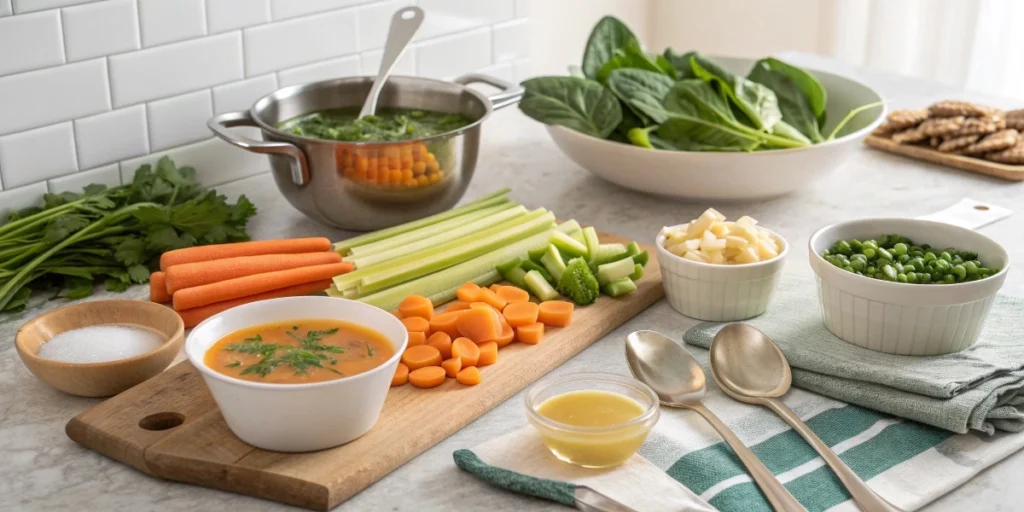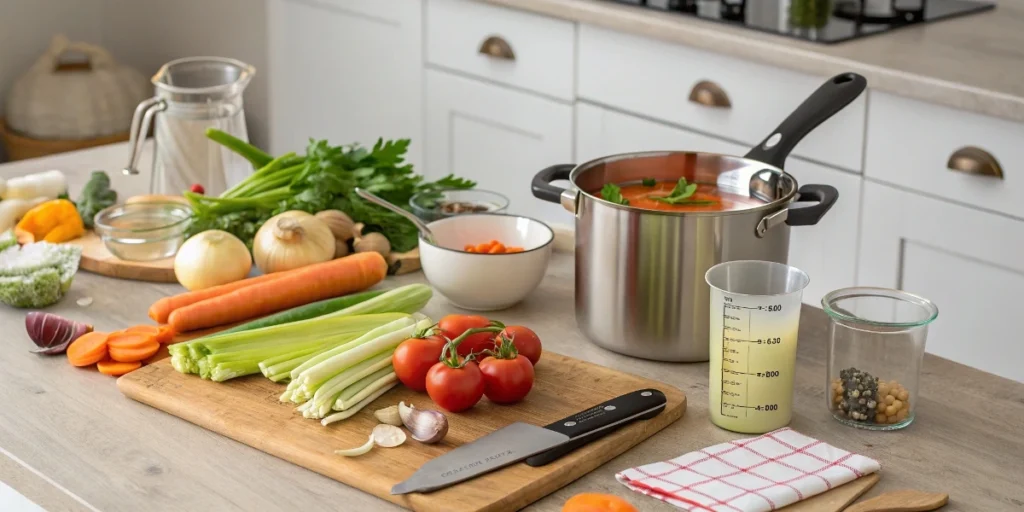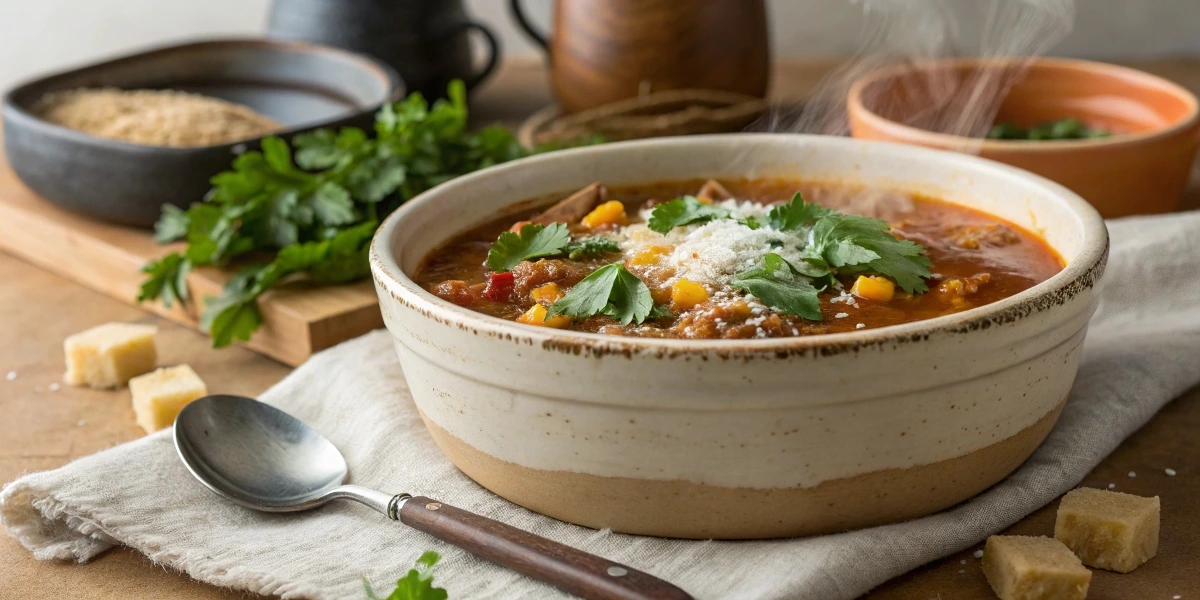Are you craving a bowl of soup but want to keep it light on calories? Maybe you’re thinking, “Can soup actually be low in calories?” Well, the good news is, yes! Some soups are not only light on the waistline but also packed with flavor and nutrients. So, what soup is lowest in calories? Let’s explore this tasty and satisfying question together and dive into some delicious options you can easily add to your meal rotation.
Table of Contents
Overview: What Soup Is Lowest in Calories?
Discover the healthiest soup options with the lowest calories, perfect for a light meal or weight-loss diet.
When you’re aiming to eat lighter, you might be looking for soups that won’t pack on the pounds. But here’s the thing: some soups can be both low in calories and rich in flavor! What makes these soups special is their balance of fresh ingredients like veggies, lean proteins, and minimal use of creamy bases or heavy fats.
These low-calorie soups are often quick to prepare, so they fit perfectly into busy lifestyles, and they’re perfect for anyone looking to enjoy a comforting meal without guilt.
Time Requirements & Difficulty Level for the Lowest-Calorie Soups
Want to know what soup is lowest in calories and how long it takes to prepare? The great part about these soups is that they don’t take hours to cook. Most can be ready in under 30 minutes, making them a perfect go-to meal for lunch or dinner. Whether you’re a beginner or an experienced cook, these recipes are simple to follow.
Essential Ingredients: What You Need for the Lowest-Calorie Soups
The key to making the lowest-calorie soups lies in choosing the right ingredients. You don’t need heavy cream, oils, or butter to create a flavorful dish. Instead, focus on these essentials:
Main Ingredients

- Vegetables: Fresh or frozen, low-calorie vegetables like tomatoes, carrots, celery, spinach, and zucchini provide fiber and nutrients while keeping your soup light.
- Broth: Opt for a low-sodium vegetable or chicken broth as the base to keep calorie counts low while adding depth of flavor.
- Lean Proteins: Chicken breast, turkey, or tofu offer protein without excess calories.
- Herbs & Spices: Use basil, thyme, cilantro, and garlic to enhance flavor without extra calories.
Alternatives and Differences
- For a creamy texture: Instead of heavy cream, use pureed cauliflower or blended cashews to achieve a rich, creamy consistency while keeping it low in calories.
- For extra greens: Adding spinach, kale, or Swiss chard boosts nutrition while keeping your soup light.
By focusing on these ingredients, you can easily prepare the lowest-calorie soups that are both delicious and satisfying.
Step-by-Step Instructions: How to Make the Lowest-Calorie Soups?
Follow these easy steps to create delicious, low-calorie soups packed with nutrients and flavor.
Now let’s get into the fun part—cooking! Here’s a simple process for creating your own low-calorie soup. I’ll give you one of the most popular low-calorie soups you can easily recreate at home.
Low-Calorie Vegetable Soup Recipe

Ingredients:
- 1 tablespoon olive oil (optional)
- 1 medium onion, chopped
- 2 cloves garlic, minced
- 3 cups low-sodium vegetable broth
- 2 cups chopped tomatoes (fresh or canned)
- 2 carrots, sliced
- 2 zucchini, chopped
- 2 cups spinach or kale
- Salt and pepper to taste
- Fresh herbs (basil or thyme)
Instructions:
- Prep the veggies: Chop all your vegetables into bite-sized pieces. This will help them cook quickly and evenly.
- Cook the aromatics: In a large pot, heat olive oil over medium heat. Add chopped onions and garlic. Cook until the onions are soft and translucent (about 3-4 minutes). If you’re keeping the soup oil-free, just sauté the veggies in a splash of water.
- Add the broth and vegetables: Pour in the vegetable broth and add the tomatoes, carrots, zucchini, and any other veggies you’re using. Bring to a simmer and cook for 10-15 minutes, or until the vegetables are tender.
- Season to taste: Add salt, pepper, and herbs like basil or thyme. Taste and adjust seasoning as needed.
- Add the greens: Stir in the spinach or kale and let it cook for another 2-3 minutes until wilted.
- Serve and enjoy: Ladle the soup into bowls, and garnish with fresh herbs for an extra pop of flavor. Enjoy your low-calorie vegetable soup!
Cooking Tips:
- Sautéing with broth instead of oil is a great way to reduce the calorie count and still get a rich flavor.
- Use frozen vegetables for convenience and cost-effectiveness. They’re just as nutritious and will work well in your soup.
- For extra protein, add some cooked chicken breast or tofu right at the end.
Assembly: Building Your Low-Calorie Soup
To build the perfect low-calorie soup, focus on layering flavors and textures. Start with a flavorful broth as your base, then add hearty vegetables for both substance and nutrition. Finish with protein and greens to round out the meal. You can also add a squeeze of lemon or a dash of hot sauce to give your soup an extra boost!
Presentation Tips:
- Garnish with fresh herbs: Fresh cilantro or parsley can elevate your soup’s look and flavor.
- Serve with whole grain crackers or a side salad to complement the meal without adding extra calories.
Storage and Makeup Tips: Keeping Your Soup Fresh
Low-calorie soups are great for leftovers! Here’s how to store and reheat them for later enjoyment:
- Storage: Allow the soup to cool completely, then store it in an airtight container in the fridge for up to 3-4 days.
- Freezing: You can freeze low-calorie soups in individual portions for up to 3 months. Just be sure to use a freezer-safe container or zip-lock bags.
- Reheating: To reheat, simply heat the soup in a pot on low-medium heat until hot. Add a bit of water or broth if it’s too thick after storing.
Low-Calorie Vegetable Soup Recipe: The Best Option for a Light Meal
Low-calorie soups are incredibly versatile! Here are some fun ideas to mix things up:
- Spicy Tomato Soup: Add a bit of heat with chili flakes, jalapeños, or hot sauce for a spicy kick. Pair with a dollop of Greek yogurt to balance the spice.
- Chicken & Vegetable Soup: Add some lean chicken breast to your vegetable soup to increase protein and make it a more filling meal.
- Cauliflower Chowder: Use cauliflower as a base to create a creamy, low-calorie chowder without any heavy cream. Blend half of the cauliflower to create a smooth texture.
- Minestrone Soup: Add whole grains like quinoa or brown rice for a hearty twist on the classic Italian minestrone.
Conclusion: Ready to Dig Into Low-Calorie Soups?
The beauty of low-calorie soups is that they are not only satisfying but incredibly easy to customize. By focusing on healthy, nutrient-dense ingredients like vegetables, lean proteins, and fresh herbs, you can create delicious soups that are both low in calories and high in flavor. So, next time you’re craving a bowl of something warm and comforting, try one of these recipes to satisfy your taste buds without the guilt. You’ll be amazed at how tasty and nutritious a low-calorie soup can be!
FAQs: Common Questions About Low-Calorie Soups
1. What is the lowest-calorie soup I can make?
Vegetable broth-based soups, with a variety of fresh veggies and lean protein (like chicken or tofu), tend to be the lowest in calories. Avoid creamy bases to keep calories at bay.
2. Can I make low-calorie soups ahead of time?
Yes! Most low-calorie soups can be made ahead of time and stored in the fridge for a few days or frozen for later.
3. How can I add more flavor to my low-calorie soups without increasing the calories?
Try adding fresh herbs, spices, or a splash of lemon juice. You can also use low-sodium broth or season with salt-free seasoning blends.
4. Are low-calorie soups filling?
Absolutely! By using a variety of vegetables and adding lean protein, these soups can be very filling and satisfying without being calorie-heavy.
5. Can I freeze low-calorie soups?
Yes, most low-calorie soups freeze well. Just ensure the soup cools completely before freezing it in an airtight container.
Enjoy crafting your own low-calorie soup masterpiece—your body (and taste buds) will thank you.

